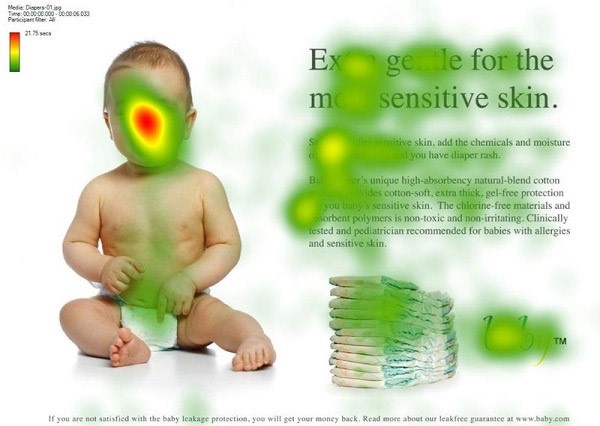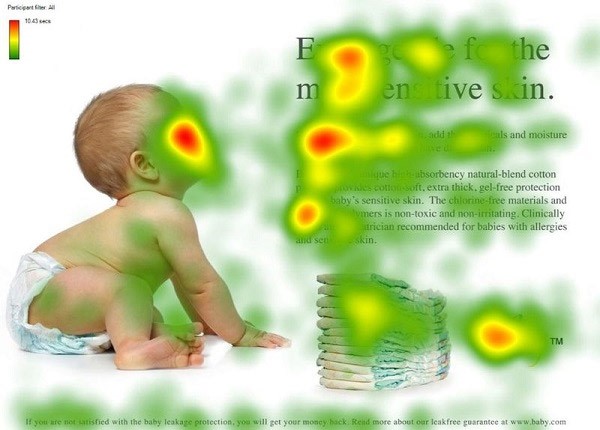-
Biometrics
Biometrics
Eye Tracking
How it Works
Devices
Metrics
Fixations and Saccades
Heat Maps
Pupillometry
Eye Language
Applications
Electroencephalography
Frequency-based Analysis
Metrics
Approach-Avoidance
Cognitive-Affective
Facial Coding
Facial Expressions
Facial Action Coding System
Metrics
Analysis
Applications
Galvanic Skin Response
Devices
Analysing GSR Signals
Metrics
Applications
Biometrics — Applications
- How Advertising Works
- Advertising Analytics
- Packaging
- Biometrics
- Marketing Education
- Is Marketing Education Fluffy and Weak?
- How to Choose the Right Marketing Simulator
- Self-Learners: Experiential Learning to Adapt to the New Age of Marketing
- Negotiation Skills Training for Retailers, Marketers, Trade Marketers and Category Managers
- Simulators becoming essential Training Platforms
- What they SHOULD TEACH at Business Schools
- Experiential Learning through Marketing Simulators
-
MarketingMind
Biometrics
Biometrics
Eye Tracking
How it Works
Devices
Metrics
Fixations and Saccades
Heat Maps
Pupillometry
Eye Language
Applications
Electroencephalography
Frequency-based Analysis
Metrics
Approach-Avoidance
Cognitive-Affective
Facial Coding
Facial Expressions
Facial Action Coding System
Metrics
Analysis
Applications
Galvanic Skin Response
Devices
Analysing GSR Signals
Metrics
Applications
Biometrics — Applications
- How Advertising Works
- Advertising Analytics
- Packaging
- Biometrics
- Marketing Education
- Is Marketing Education Fluffy and Weak?
- How to Choose the Right Marketing Simulator
- Self-Learners: Experiential Learning to Adapt to the New Age of Marketing
- Negotiation Skills Training for Retailers, Marketers, Trade Marketers and Category Managers
- Simulators becoming essential Training Platforms
- What they SHOULD TEACH at Business Schools
- Experiential Learning through Marketing Simulators
Applications of Eye Tracking


Exhibit 15.10 Use of heat maps to illustrate the differences in impact between two versions of an ad. Lower version succeeds in drawing attention to the advertising messages by the suggestive directional cue of the baby gazing at the text. (Source: Kissmetrics).
The use of eye tracking in consumer research is expected to grow rapidly in the coming years, with primary applications including testing of advertising, packaging, product usage, websites, and other online content.
For example, eye tracking can reveal how the layout of an advertisement or webpage affects viewers’ attention and comprehension. Heat maps generated by eye tracking can show which areas of an image or text viewers are fixating on, allowing marketers to optimize their design for maximum impact.
In the oft quoted example shown in Exhibit 15.10, there are key differences in the heat maps for two similar diaper advertisements. In the first version of the ad where the baby is facing the viewers, they are focussed mainly on the baby’s face. This visual may score on viewership but it fails to generate the right kind of attention.
In contrast, the lower version of the ad, succeeds in drawing attention to the advertising messages by using the suggestive directional cue of the baby gazing at the text. This subtly draws viewers’ attention to the key messages contained in the text of the advertisement.
Eye tracking can also be used to assess emotional arousal through pupil dilation, although additional biometric techniques such as facial coding or EEG may be needed to decipher the nature of the emotions being experienced.
While testing applications like websites, eye tracking is used to assess usability and user experiences. The fixation time, for instance, is an indicator of the ease of absorbing information. Excessive time spent reading general information or basic instructions may indicate difficulties in understanding the content, resulting in a negative user experience.
The time to first-fixation reveals the extent to which key elements are able to grab viewers’ attention. A key metric for packaging testing the time to first-fixation captures the packaging’s ability to stand out on the shelf.
Eye tracking may also be used for studying the usage of products that require skill and familiarity from the user, such as computer games, computer-aided applications, automobiles, airplanes, and sports product. In the field of Human computer interaction (HCI), eye tracking is becoming increasingly important for designing better computer systems and software applications. By studying users’ eye movements, engineers and designers gain insights into how people interact with technology, and use these insights to improve the user experience.
Simulators for automobiles (or airplanes) use eye tracking and other sensors to understand how drivers drive, and how they respond to danger and obstacles on the road. The devices can reveal how speeding and reckless driving can impair visual attention, and help engineers build safer and easier to use products.
Eye trackers have the potential to become integral to products that utilize the information these devices capture. For instance, automobiles with eye tracking technology can be designed to respond to the driver’s gaze, eye movements, or pupil dilation. If the driver’s eyes stray off the road or if the driver starts falling asleep, the vehicle could be designed to respond accordingly to prevent an accident.
There is scope for use of eye tracking in interactive television and in applications that are interactive in nature.
There is considerable scope too, largely untapped for now, in virtual reality simulation. By using eye tracking, users can seamlessly navigate virtual environments by simply looking at the desired location or object. This enhances the overall user experience and makes virtual simulations more realistic, making them more useful for consumer research such as simulated store tests and virtual in-store shopping behaviour studies.
However, eye tracking has limitations, as it only shows where the eyes are headed and not what the mind perceives. Sometimes the mind is so preoccupied, that the eyes do not register what lies in the direction of their ray of sight. For instance, when someone looks right through you. Or for instance when a banner ad is the viewer’s line of sight, but she is not perceiving it.
To fully understand respondents’ perceptions and emotions, eye tracking needs to be used in conjunction with research and analytic techniques in conventional quantitative and qualitative research as well as other biometric tools like EEG and facial coding.
Eye tracking is used in conjunction with EEGs to identify the elements in a visual that stir emotions, and with facial coding devices to reveal the aspects that evoke facial expressions. Details of how eye tracking may be used in conjunction with other biometric devices, are covered in the section Applications of Biometrics in Marketing.
Previous Next
Use the Search Bar to find content on MarketingMind.
Contact | Privacy Statement | Disclaimer: Opinions and views expressed on www.ashokcharan.com are the author’s personal views, and do not represent the official views of the National University of Singapore (NUS) or the NUS Business School | © Copyright 2013-2025 www.ashokcharan.com. All Rights Reserved.





